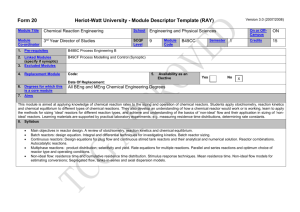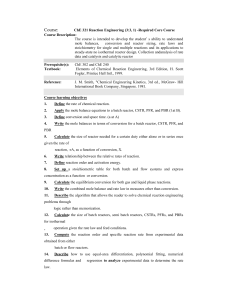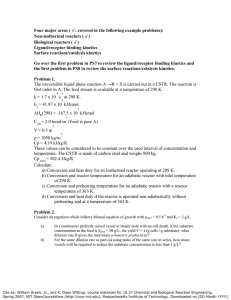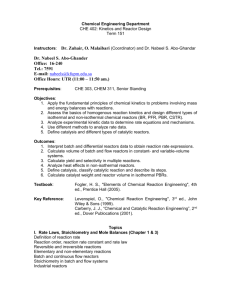COURSE SESSION INSTRUCTOR
advertisement
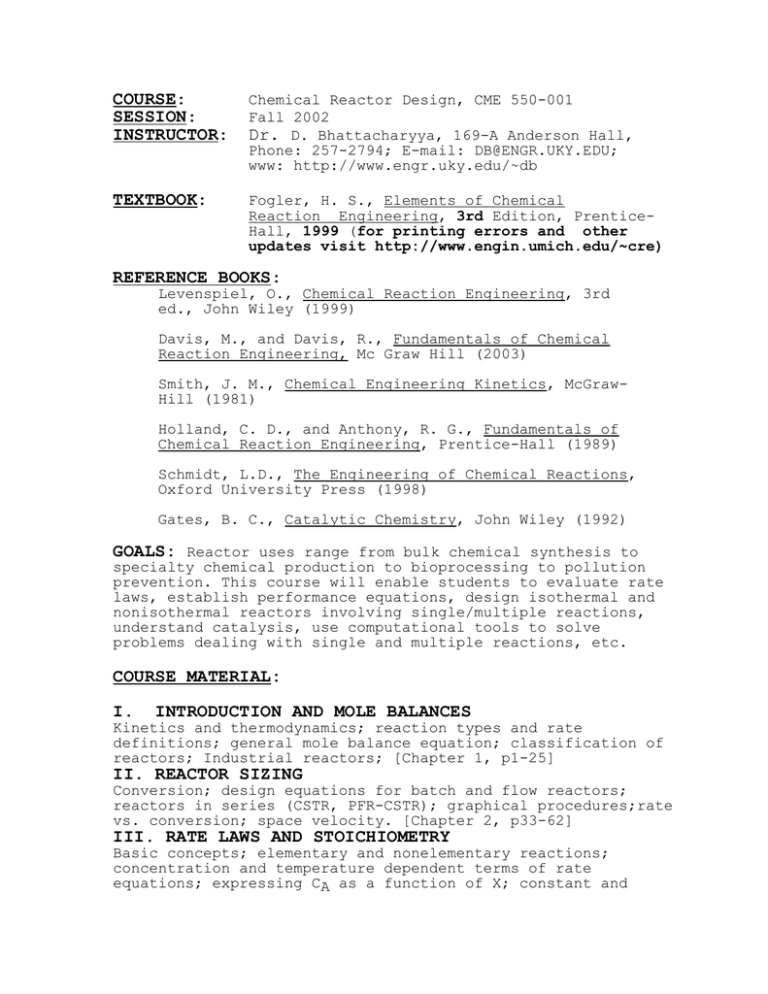
COURSE: SESSION: INSTRUCTOR: Chemical Reactor Design, CME 550-001 Fall 2002 Dr. D. Bhattacharyya, 169-A Anderson Hall, Phone: 257-2794; E-mail: DB@ENGR.UKY.EDU; www: http://www.engr.uky.edu/~db TEXTBOOK: Fogler, H. S., Elements of Chemical Reaction Engineering, 3rd Edition, PrenticeHall, 1999 (for printing errors and other updates visit http://www.engin.umich.edu/~cre) REFERENCE BOOKS: Levenspiel, O., Chemical Reaction Engineering, 3rd ed., John Wiley (1999) Davis, M., and Davis, R., Fundamentals of Chemical Reaction Engineering, Mc Graw Hill (2003) Smith, J. M., Chemical Engineering Kinetics, McGrawHill (1981) Holland, C. D., and Anthony, R. G., Fundamentals of Chemical Reaction Engineering, Prentice-Hall (1989) Schmidt, L.D., The Engineering of Chemical Reactions, Oxford University Press (1998) Gates, B. C., Catalytic Chemistry, John Wiley (1992) GOALS: Reactor uses range from bulk chemical synthesis to specialty chemical production to bioprocessing to pollution prevention. This course will enable students to evaluate rate laws, establish performance equations, design isothermal and nonisothermal reactors involving single/multiple reactions, understand catalysis, use computational tools to solve problems dealing with single and multiple reactions, etc. COURSE MATERIAL: I. INTRODUCTION AND MOLE BALANCES Kinetics and thermodynamics; reaction types and rate definitions; general mole balance equation; classification of reactors; Industrial reactors; [Chapter 1, p1-25] II. REACTOR SIZING Conversion; design equations for batch and flow reactors; reactors in series (CSTR, PFR-CSTR); graphical procedures;rate vs. conversion; space velocity. [Chapter 2, p33-62] III. RATE LAWS AND STOICHIOMETRY Basic concepts; elementary and nonelementary reactions; concentration and temperature dependent terms of rate equations; expressing CA as a function of X; constant and 2 variable volume reaction systems; reversible reactions; reactions with phase change. [Chapter 3, p68-113] IV. ISOTHERMAL REACTOR DESIGN General design procedure; irreversible and reversible reactions; CSTR and tubular reactors; pressure drop; unsteadystate CSTR; semibatch reactors; ethylene glycol production; Membrane Reactors; Recycle reactors [Chapter 4, p125-167, 173196, 201-204] and laminar-flow reactor V. ANALYSIS OF RATE DATA Differential and integral methods; method of initial rates and t1/2 values; differential reactors [Chapter 5, p223-259] VI. MULTIPLE REACTIONS Series and parallel reactions; selectivity, yield and optimization considerations; complex reactions [Chapter 6, p282-320] VII. NONISOTHERMAL REACTOR DESIGN Energy balance; steady state CSTR and PFR/PBR reactors; adiabatic reactors; equilibrium conversion; interstage cooling; adiabatic batch reactors; multiple steady states in CSTR; mutiple reactions [Chapter 8, p426-498, p500-510, and Chapter 9 p537-547] VIII. EXTERNAL MASS TRANSFER (HETEROGENEOUS RXNS) Basic concepts; diffusion/reaction limited regimes; packed bed reactor; monolith reactor. [Chapter 11, p686-719] IX. CATALYSIS Definitions; rate eqns.; surface phenomenon; rate limiting step; design eqns for gas-solid rxns; catalyst deactivation; Diff. & rxns in porous catalysts (Thiele modulus).[Ch.10, p581- 622, p627-630, [Ch12, p738-747] X. SPECIAL TOPICS Enzyme reactions(Chapter 7, p383-393); Reactive distillation (Ch 4, p197-200); Pollution Control (Advanced oxidation/reduction) EXAMS, HOMEWORK/COMPUTER PROBLEMS and Project: Homework and computer problems/project: as assigned in class Grading: Homework and computer problems and project: Concept quizzes 15% EXAMS I and II 40% Final Exam 30% NOTE: MAPLE/Aspen Plus software will be used in this 15% 3 course. In addition, you will be using the KINETIC INTERACTIVE MODULES, and other review materials in your CD-ROM. Read Preface Section E and F of your textbook to learn about the contents of CD-ROM. Some lecture materials, class handouts, homework solutions, etc. will also be in my WWW pages. Course Objectives and Expected Outcomes: 1. Formulate and solve various problems involving batch and continuous flow reactors. 2. Understanding of elementary and non-elementary reactions. 3. Optimization and design of isothermal and nonisothermal reactors. 4. Analysis and interpretation of rate data. 5. Solve problems involving diffusion and reaction in catalytic reactors. 6. Analyze and solve problems involving novel reactors (membrane reactors, enzyme catalysis). 7. Use of computer tools to analyze (various scenarios) and solve various types of reactor problems. 8. Communication and group work involving selected class presentations, homework problems, and project. 9. Application of reactor design principles to solve problems in environmental and pharmaceutical area.
